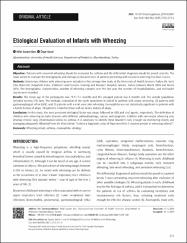| dc.contributor.author | Susam Şen, Hilal | |
| dc.contributor.author | Vural, Özge | |
| dc.date.accessioned | 2022-07-05T08:23:16Z | |
| dc.date.available | 2022-07-05T08:23:16Z | |
| dc.date.issued | 2021 | en_US |
| dc.identifier.citation | Şen, H. S., & Vural, Ö. (2021). Etiological Evaluation of Infants with Wheezing. | en_US |
| dc.identifier.issn | 2651-3153 | |
| dc.identifier.uri | https://doi.org/10.4274/eamr.galenos.2019.65487 | |
| dc.identifier.uri | https://hdl.handle.net/20.500.12933/1321 | |
| dc.description.abstract | Objective: Patients with recurrent wheezing should be evaluated for asthma and the differential diagnosis should be posed carefully. The
study aimed to evaluate the demographic and etiological characteristics of patients presenting with recurrent wheezing less than 3 years.
Methods: Ninety‐two children with wheezing were included in this retrospective study at the University of Health Sciences Turkey, Dr. Sami
Ulus Maternity Outpatient Clinic, Children’s and Diseases Training and Research Hospital, Ankara, Turkey between March 2009 and March
2010. The demographic characteristics, number of wheezing episodes over the last year, the number of hospitalizations, and eosinophil
counts were recorded.
Results: The mean age of the participants was 19.9+-9.4 months and the youngest patient was 6 months old. The sample population
included seventy (70) boys. The etiologic evaluation of the study population included 42 patients with atopic wheezing, 28 patients with
gastroesophageal reflux (GER), and 23 patients with a viral associated wheezing. Eosinophilia was not statistically significant in patients with
a family history of atopy (18 patients) related to those with no family history of atopy.
Conclusion: In this study, the most prevalent etiological factor was atopy, followed by GER and viral agents, respectively. The definition of
children with wheezing includes diseases with different pathophysiology, course, and prognosis. Children with non-atopic wheezing may
develop chronic lung inflammation similar to asthma. It is necessary to identify these disorders early enough via monitoring closely and
managing adequately. Obtained from the thesis titled, “Is there a diagnostic value of high-sensitivity C-reactive protein in wheezing infants?”. | en_US |
| dc.language.iso | eng | en_US |
| dc.publisher | Galenos Yayınevi | en_US |
| dc.relation.isversionof | 10.4274/eamr.galenos.2019.65487 | en_US |
| dc.rights | info:eu-repo/semantics/openAccess | en_US |
| dc.subject | Wheezing infant | en_US |
| dc.subject | Asthma | en_US |
| dc.subject | Eosinophilia | en_US |
| dc.subject | Etiology | en_US |
| dc.title | Etiological Evaluation of Infants with Wheezing | en_US |
| dc.type | article | en_US |
| dc.authorid | 0000-0002-1329-1287 | en_US |
| dc.authorid | 0000-0001-7523-7553 | en_US |
| dc.department | AFSÜ, Tıp Fakültesi, Dahili Tıp Bilimleri Bölümü, Çocuk Sağlığı ve Hastalıkları Ana Bilim Dalı | en_US |
| dc.contributor.institutionauthor | Susam Şen, Hilal | |
| dc.contributor.institutionauthor | Vural, Özge | |
| dc.identifier.volume | 37 | en_US |
| dc.identifier.issue | 4 | en_US |
| dc.identifier.startpage | 213 | en_US |
| dc.identifier.endpage | 216 | en_US |
| dc.relation.journal | European Archives of Medical Research | en_US |
| dc.relation.publicationcategory | Makale - Uluslararası Hakemli Dergi - Kurum Öğretim Elemanı | en_US |
















